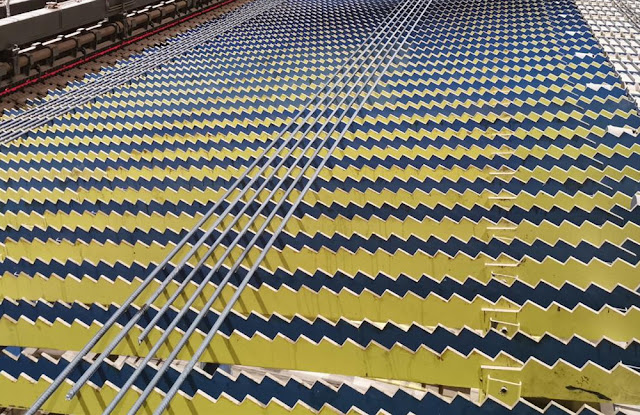The cooling bed is the working table of the metallurgical steel rolling industry to cool rolled products (rebar, round steel, steel pipe, etc.). The cooling bed is composed of the mechanical transmission system, water cooling system, cooling bed table, fixed support, etc. The cooling beds mainly include gear extraction cooling bed, walking beam cooling bed, claw type cooling bed, carrying chain cooling bed, rolling plate cooling bed, etc.
The cooling bed is one of the indispensable auxiliary equipment in small and medium-sized bar mill plants. Its function is to cut double-length bar rolled by rolling mill through flying shear, transport and unload it to the rack of cooling bed for cooling, so as to reduce its temperature from 900 ℃ to 100 ~ 300 ℃. Then it is collected and sent to output roller table by unloading device of cooling bed, and then it is sent to cold shear for cutting into fixed-length finished product by output roller table. The design quality and installation accuracy of the cooling bed directly determine the final quality of products.
Equipment Composition
The cooling bed consists of three parts: cooling bed feeding device, serrated walking beam cooling bed body, cooling bed unloading device and output roller table. The cooling bed charging device is a difficult point in the design of the cooling bed, and it is also a throat device.
Feeding Device
The feeding device is composed of a roll-in roller table, a straightening plate, a brake apron and a pneumatic steel splitting device. The structural feature of the feeding device is that a hydraulic cylinder is arranged every 12m in the length direction of 120m, all hydraulic cylinders operate synchronously, and the skirt board is moved up and down at the same time through the connecting rod and the synchronous shaft.
The performance characteristics of the feeding device are: a proximity switch is set on the synchronization axis to detect and control the lifting position of the lifting skirt to ensure accurate and reliable actions; the control valve of the hydraulic cylinder is configured nearby to minimize pressure errors and ensure synchronization of actions The direct-acting relief valve and anti-cavitation valve are set in the control circuit, and the optimized design of the hydraulic cylinder can effectively solve the problem of damage to the hydraulic system caused by the huge impact and ensure the safety of the hydraulic system.
The side drive of the hydraulic cylinder, the synchronous shaft is arranged outside the high-temperature zone. When each hydraulic cylinder is kept in sync, each shaft bears only the torsional stress required for the lifting of the lifting skirt plate, while the synchronous shaft is rotated. There is almost no inertial force. Because the inertial force of the skirt is distributed to each hydraulic cylinder, the force state of the mechanism is greatly improved.
There is an adjustment mechanism on the connecting rod, which can easily adjust the up and down position of the skirt board. Due to the optimized design of the mechanical structure, the electrical control adopts computational control technology, and the hydraulic system adopts safety measures, the device is endowed with superior performance. The levelness and straightness of all skirts are reliably guaranteed during work.
Classification
Cooling beds mainly include pull-tooth cooling beds, rack stepping cooling beds, claw cooling beds, carrier chain cooling beds, and rolling plate cooling beds.
Working Principle
The rolled products are transported into the cooling bed through the roller table, and then the workpieces arranged on the cooling bed are gradually moved to the top of the cooling bed by means of rack and gear stepping, so as to achieve the cooling effect of the workpiece.
The Main Purpose
The cooling bed equipment is mainly used for on-line slow natural cooling of rolled steel plates. In the profile production line, the cooling bed also has a pre-bending function for the profile to prevent the profile from being irregularly bent due to unequal quality in the natural cooling process. Cooling beds are mainly used in the steel industry, metallurgical industry, etc.
Operating Procedures
1. During the rolling process, the operators of the cooling bed are strictly forbidden to go on the cooling bed, and are not allowed to walk on the roller table or rack.
2. If there are accidents such as chaotic bed during production, it must be processed and cleared after the rolling stop.
3. The sampling of the cooling bed should use special tools for sampling.
4. Pay attention to the surrounding conditions during operation, and it is strictly forbidden for unrelated persons to enter the dangerous area of the large cooling bed.
5. Hot waste products caused by accidents such as chaotic beds must be removed on duty to ensure that the environment around the cooling bed is tidy.
If you are interested in cooling beds for rolling mill machine, please mail at marketing2@hanrm.com.
More Articles You May Be Interested in:
What are the Main Advantages of the Step-Type Cooling Bed?
Bar Rolling Process and Equipment Selection
The Advantages and Disadvantages of Hot Rolling
Hot Rolled Steel and Cold Rolled Steel
Hot Rolling Process VS Cold Rolling Process
What’s the difference between hot and cold rolling mills?
Features of Hot Rolling and Controlled Cooling
What is Metallurgical Equipment?




No comments:
Post a Comment